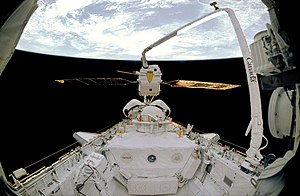Exobiology Radiation Assembly
[1] It was launched 31 July 1992 by the STS-46 - Space Shuttle Atlantis and put into orbit at an altitude of 508 km.
It was retrieved on 1 July 1993 by STS-57- Space Shuttle Endeavour and returned to Earth for further analysis.
The experiment's goal was to study the response of dehydrated and metabolically dormant microorganisms (spores of Bacillus subtilis, cells of Deinococcus radiodurans, conidial spores of Aspergillus species) and cellular constituents (plasmid DNA, proteins, purple membranes, amino acids, urea) to the extremely dehydrating conditions of outer space, in some cases in combination with irradiation by solar UV light.
Spores of different strains of Bacillus subtilis and the Escherichia coli plasmid pUC19 were exposed to selected conditions of space (space vacuum and/or defined wavebands and intensities of solar ultraviolet radiation).
After the approximately 11-month mission, the organisms' responses were studied in terms of survival, mutagenesis in the his (B. subtilis) or lac locus (pUC19), induction of DNA strand breaks, efficiency of DNA repair systems, and the role of external protective agents.
